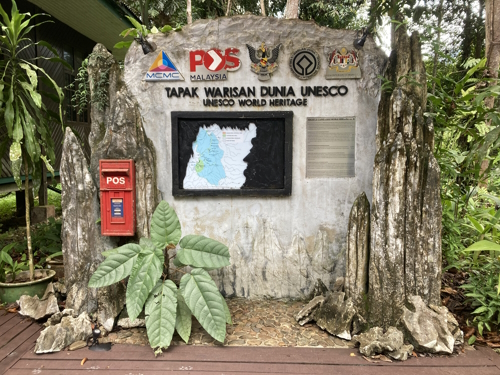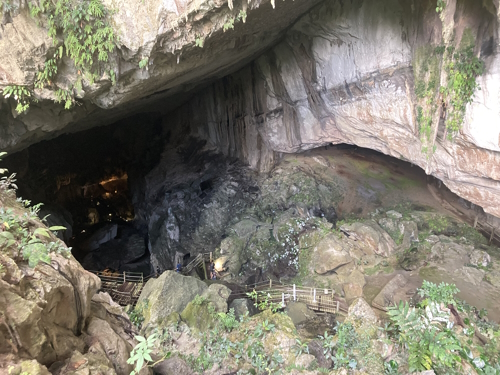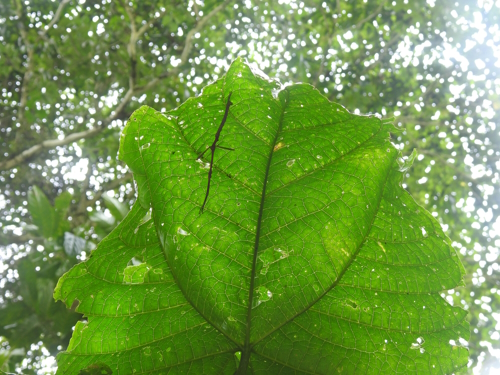Blog WHS Visits
WHS #833: Gunung Mulu
Gunung Mulu National Park scores in superlatives. Mulu has the Second Biggest Cave Chamber in the world (Sarawak Chamber), the Largest Cave Passage (Deer Cave), and one of the Largest interconnected cave systems (Clearwater Cave System). It has among the highest number of palm tree species anywhere ánd even the longest canopy walkway. It has been inscribed as a WHS on all 4 natural criteria. Even on our website, it ranks 30th of all 1157 WHS, with an average score of 4.5.
Despite knowing all these accolades, it blows you away on arrival. Its rainforest setting is stunning, it is much prettier than pictures can convey. I found it especially hard to take good photos here, I took over 500 and kept only 90 or so. I tried all kinds of settings, both on my large zoom camera and my phone, to no avail (others had more success with their latest generation high-end iPhones). The rainforest and the cave interiors are very dark, and pouring rain doesn’t help either. Animals are either very skittish or tiny. Trees, cave entrances (photo 2) and stick insects (photo 3) are the best bets!
The park is very well-managed from a visitor's perspective and accessible to all. One of the guides joked that you can see the Sarawak Chamber for only 35 ringgit (7 USD), while Son Doong in Vietnam (which recently surpassed it as the Biggest Cave Chamber) takes a 5-day expedition costing 3000 USD. I took 3 guided tours in Mulu, the 4th, the Night Walk, was cancelled twice due to heavy rain resulting in the danger of falling tree branches. The Clearwater Caves tour was my favourite as it also included a boat ride and a refreshing swim at the end. Caves still really aren’t my thing; remember my adage: “dripstone caves are the same everywhere in the world”. Some Mulu caves ‘specialize’ in dripstone effects (the Lang Cave is probably the best), while others stand out for being large spaces.
Watching the ‘Exodus of the Bats’ from the Deer Cave is the park’s main event, and will attract small crowds daily around 5.30 pm. The bats however do not always show, they don’t like to go out when it rains (“How do they know?” my Taiwanese neighbour waiting at the ‘theatre’ rightly asked.). On my second day, I was lucky enough to see them fly – they appear in ‘batches’, groups flying together and making curved patterns in the sky.
Fauna wise you don’t need to come here for anything bigger than a stick insect. Only the cute Borneo Pygmy Squirrel (7.5 cm including tail) is easy to see running and jumping around. From the canopy walk, I also spotted what the guide said was a ‘medium’ squirrel (prob. Prevost’s) – somewhere in between in size between the pygmy and the giant squirrels. Birds also are hard to see. Notable only was one Indian paradise flycatcher and six long-crested hornbills flying overhead in the morning, their wings making a swoosh-swoosh sound.
The lack of mammals surely has to do with hunting. This area has only been protected as a National Park since 1974. Nomadic Penan people are still allowed to hunt deeper in the park. On the Clearwater tour you will visit the village of Batu Bungan (or mostly its handicraft market), there you can try out a blowpipe they use for traditional hunting. The tips of these practice arrows of course are not covered in poison – “but we have a poison tree next to the school!”. The village still has no 24/7 electricity and opposes plans of the Sarawak government of giving up their community lands in favour of a highway and extension of the airport.
Finally, some practical tips for visiting:
- Book for 1 day longer than you think you need because activities can get cancelled because of the rain (every afternoon there’s a high probability).
- Fill your days with guided activities. There are self-guided trails as well but they aren’t that interesting and take little time anyway.
- Bring snacks: there’s a small shop (and a café) at the Park Headquarters but it does not have the variety of the neighbourhood 7-Eleven you find in any Malaysian town.
- Stay in one of the Deluxe Garden Bungalows inside the park. At 270 ringgit (ca. 54 EUR) per night including breakfast they are worth it. I booked with the Park Office 2 months ahead.
- Bring quick-drying clothes. Chances are that you get soaking wet twice a day, due to sweating in the high humidity and daily rain.
- Book early flights in and out. The weather is usually clear in the mornings. Flights to Miri seem to be most prone to delays, those to Kuching less so.
Els - 12 March 2023
Comments
Shandos Cleaver 3 April 2023
By coincidence we visited Mulu back in the days before we started trying to visit WHS, despite it's remote location. Such a spectacular place! Although we were late booking and could only get into the dorms.
Els Slots 12 March 2023
Yes. Sarawak I did on my own. Also visited Bako NP, Kuching (inc. Semenggoh), Miri and the Niah Caves. Malaysia only slowly is getting back to normal.
Michael Ayers 12 March 2023
It was almost exactly one year ago that I was there. That was at the very beginning of the reopening period, and visiting Malaysia was rather bizarre at that time. Were you able to get to Sarawak independently?
Els Slots 12 March 2023
Nope. Although it is pretty popular among the younger crowd of visitors.
Zoë Sheng 12 March 2023
One of my favorites. Fond memories. Will go back one day.
Take it you didn't go for the 4 day hike to the karst peaks?


